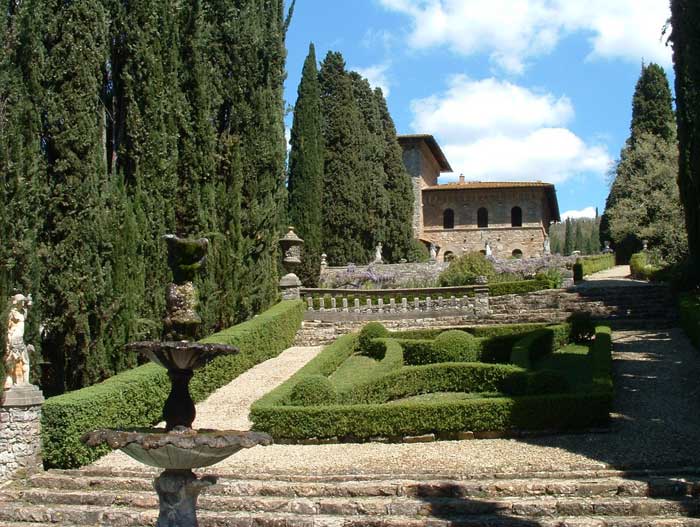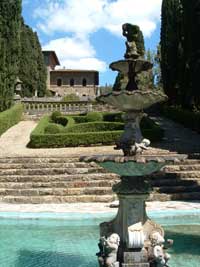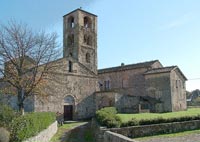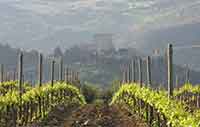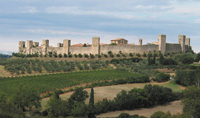| |
|
|
| |
|
|
|
|
|
Podere Santa Pia, view from the garden
on the valley below
|
|
Podere Santa Pia |
|
Florence, Duomo |
| |
|
|
|
|
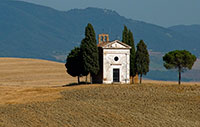
|
|
|
|
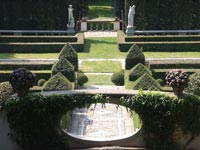
|
Capella Vialetta, near Pienza
|
|
Sovicille |
|
Villa I Tatti |
| |
|
|
|
|
|
|
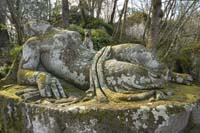
|
|
|
Podere Santa Pia, famous wines in southern Tuscany
|
|
Il parco dei Mostri di Bomarzo |
|
Monterriggioni |

Aroud 1450 Leon Battista Alberti, (architect, mathematic, critic, philosopher) built up a theory regarding the ideal villas and gardens in Florence, both had to recall the quiet and peaceful life that the emergent new middle class was pursuing so that,
from then the Florence gardens had also a social aim with new and modern prospects of development.
The gardens architecture was considered an art and provided geometric flowerbeds and surrounded by a wall to allow an inner private space. The first to acknowledge and to carry out this new ideas was Medici family who committed Michcelozzo to restore and rebuilt the Cafaggiolo Villa and the Careggi Villa. Lorenzo de’ Medici committed to Giuliano da Sangallo the restyling of the villa in Poggio a Caiano. In these gardens were conceived many of the most important poems and art works of this period. In the last years of th1 15th century there were 138 gardens in Florence.
Boboli garden
One of the most important garden architects in Florence in the 16th century was Niccolò di Raffaello, called “Tribolo”. He planned the garden in Villa di Castello (1540) and Boboli garden behind the Pitti family palace which Cosimo the 1st has bought to have a new residence in the town. After Tribolo’s death two important architects continued the project: Luca Ammannati and Bernardo Buontalenti. Alfonso Parigi was the one who finished the big theatre in 1634. The theatre was opened in 1637 with a performance for the wedding od Ferdinando the 2nd Medici.
The garden was and is a classic example of Italian Style Garden, even if it was changed and enriched in the centuries.
With 45 thousand sqm this is not only a garden but an open museum, with statues, fountains and a theatre. You need not less than three hours to visit it. In spring do not miss the rose garden, it is a collection of ancient rose trees (in some days you can also have a guided tour) and have a look also at the lemon house. Do not also miss to climb up to the border with Forte Belvedere Garden, in spring, your hard work will be rewarded both with the view of a wonderful garden full of peonies and a panorama on the city. There is a little bar in this part of the garden where you can rest and have a coffee or an ice-cream or a drink.
Bardini Garden
From Boboli garden, through Costa a San Giorgio, you can visit a recent restored Garden: Bardini Garden. If you don’t come from Boboli you can enter in Via de’ Bardi nr 1. I suggest to visit the two gardens in different days because even if the gardens are very good and peaceful, you will get tired after having walked so much.
The garden is attached o Boboli garden, it is located among the left side of Arno river, the hill of Montecuccoli and the ancient medieval walls and it is an amazing view over Florence.
The garden was originally a loom of the Mozzi Villa (which is still now at the entrance of the garden) in 1700 it was enlarged and enriched with fountains with mosaics. In 19th century the garden was enlarged again in Victorian style. Now, after many years disagreement for the inheritance and after the intervention of the Minister of Cultural Heritage, and after a five years restoration, the garden has again its original look and its original richness of plants:
A large baroque flight of steps, six fountains with mosaics, all with rose borders. In the green theatre you can visit a bed of azaleas and also admire, camellias and many different flowers. In the agricultural part, there are fruit trees, a tunnel of wisteria and a collection of hydrangeas.
Gardens in Tuscany | Boboli and Bardini garden
Villa Demidoff Park
One of the most spectacular gardens in the Florentine area is the park of Villa Demidoff in Pratolino.
Take bus nr 25/A near the train station and in less than 30 minutes you’ll be in Pratolino a quiet nice neighbourhood of Florence.
Francesco the 1st Medici had entrusted Bernardo Buontalenti the building of the big park of his villa and Buontalenti, who was a genius architect, planned a so rich and charming park that it was considered the characteristic base of the Florentine culture in those years.
Buontalenti planned the park as a dreaming place where nature and technology
merged together to introduce the grand duke’s philosophy. The park was soon very popular for its grottoes, its fountains and its statues and it was named “the wonder garden”.
To day the park is a public park, it has still some grottoes, fountain basins and statues (the most are in Boboli Garden). The most important is the big statue of the giant of Appennino by Giambologna. Many very big trees as citrons, oaks and plane-trees make the park particularly interesting.
The ancient Medici villa was destroyed while the pages-house was turned into Villa Demidoff in 1872.
In 1605 Galileo Galilei was asked in Pratolino to explain his geometric and military compass by which he could calculate many geometric and arithmetic operations trough the proportionality of the homolog sides of two similar triangles.
Iris garden
You can visit this garden only in May: if you are in Florence in this month don’t miss it. The garden is open in May the month of the blooming of the iris or Florentine lily, sign of Florence.
Since 1251 the iris (in Florence we call it “lily” = giglio) is the symbol of Florence. It appeared also in the first silver coins in the Florentine Republic and later in the golden Florin.
The history of this logo comes from the overturning of the colours from white in red background to red in white background. This happened when, in the Middle age, the Guelfs won over the Ghibellini who had in their logo a white lily on red background and overturned the colours. Since then many tried to grow a red lily, but nobody could grow it so far.
Roses Garden
If you visit Florence in May you cannot miss this garden. In 1865 Florence new Italian capital city, asked the architect Giuseppe Poggi to renew and enlarge the town also planning new important things on the left bank of the river Arno. Among important settings as the new avenues around the city, Poggi planned Piazzale Michelangelo and on the opposite side of Iris Garden, he planned a particular garden all devoted to the roses. Here you can find ancient roses, new kinds of this flowers, and a Japanese garden which was given by Koadai-Ji Temple in Kioto to the town of Florence. All in full quiet and in front of one of the most amazing view you can have in Florence.
Giardino dei Semplici | Botanical Garden
The Duke Cosimo the 1st Medici began an important period in Florence not only for the arts but also for the science this was an instrumental role in the building of the most important gardens in the town. Cosimo the 1st greatly boosted botanical studies and founded the botanical garden of Florence in 1545. This is the period of the building of the most beautiful and important gardens of the town as Serristori Garden, Pandolfini Garden and many others.
Gardens in Tuscany | Giardino dei Semplici
Archeological Museum Garden
This beautiful garden is the garden of the Archaeological Museum, it is located in via della Colonna 38 near Piazza SS. Annnunziata you can visit it only on Saturday morning, if you have no time on Saturday, you can walk along the street and have a look beyond the iron fence.
Originally it was the garden of Crocetta Palace in the early 18th century when the gardener of Boboli Garden, Francesco Romoli, made rectangular flower beds and a little citrus orchard (three of these plants are still living near SS. Annunziata Square). In each period of the year you can find different flowers.
Torrigiani Garden
In Via de’ Serragli 146 – only by appointment with a guided tour.
This Garden is one of the few large green areas to survive inside the city walls, A part of Torrigiani property: the Campuccio is known to have existed in the early 16th century. Between 1802 and 1817 the property was extended, now it spreads over 10 hectares. Today's garden, though not quite as full of attractions as in earlier centuries, has survived intact and remains Florence's most important English-style garden. Visit Baccani's famous tower which built in 1824, was planned as an astronomical observatory, it also includes a library, a collection of astronomical instruments and an open terrace for star-gazing. Many notable sculptures are in the garden.
Giardino dell’orticoltura | Plant growing Garden
Marquis Pietro Torrigiani, as chief of the Georgofili Academia founded the Tuscan society of plant growing and gardens. In 1859 Marquis Ginori gave a large plot of land to grow an experimental garden. Every year in April you can admire the flowers show, where many Florentine people go to visit and to buy new plants for their garden and terraces. The greenhouse (1880) is really spectacular. This garden is very suitable for children.
Cascine Park
This park is located on the right bank of Arno river and it is the biggest public park of Florence. In the past this area belonged to Cosimo the first Medici as game preserved and dedicated to the cattle breeding and cheese production.
After the Medici, Lorena Family built some interesting buildings including a pyramid and often allowed the Florentine people to visit the park in special circumstances.
In the 19th century the park was fully public, with horse racings, tennis, swimming pools. The old farm is now seat of the Agriculture department of the University of Florence.
Stibbert Villa Garden
This beautiful garden, which spreads out over three hectares, is the garden of the Stibbert Museum, it was designed and enlarged by Poggi architect who planned an English style garden. Her you can admire an Egyptian temple, an Hellenistic temple and a little lake.
Ventaglio Park
This park is located at the end of Viale Volta along the way to Fiesole.
Also this park has an history which dates from the 1600 and belonged to important Florentine families as Brancacci, Salvetti, Torigiani and many others. In 1967 the park was bought by the Italian State.
Petraia Villa Park
La Petraia is one of the most fascinating Medici Villas, both for the wonderful location and for the paintings and the beautiful park.
A few kilometres away from Florence, it is typical suburban villa where the Medici family, got tired by the business of the city, could relax.
An ancient building was enlarged at the end of the 16th century and a beautiful terrace garden was built around it.
In the covered court yard you can admire frescoes by Volterrano and Cosimo Daddi. Inside the palace you can admire the bronze statue of Florentine-Venus by Giambologna.
Gardens in Tuscany | Villa Petraia
Parco di Villa Reale di Castello (Villa di Castello)
Via di Castello 47, Località Castello, 50141 Firenze.
This Medici Villa was the favourite by Cosimo the 1st and it is one of the oldest Medici residences in the neighbour of Florence. The garden was planned in 1538
To celebrate the power of the young Duke with statues, fountains and caves. Her you can find orange trees and rare plants. Particularly interesting is the Animal cave which once was full of water effects and fountains.
Gardens in Tuscany | Parco di Villa Reale di Castello (Villa di Castello) in Florence
|
The Villa Peyron al Bosco di Fontelucente is a member of the Grandi Giardini Italiani, an association of major gardens in Italy. Its members include some of the most important gardens in Italy.
List of member gardens | Fondazione Pompeo Mariani (Imperia), Giardini Botanici di Stigliano (Roma), Giardini Botanici di Villa Taranto (Verbania), Giardini Botanici Hanbury (Ventimiglia), Giardini della Landriana (Roma), Giardini La Mortella (Napoli), Giardino Barbarigo Pizzoni Ardemani (Padova), Giardino Bardini (Firenze), Giardino dell'Hotel Cipriani (Venezia), Giardino di Boboli (Firenze), Giardino di Ninfa (Latina), Giardino di Palazzo del Principe, Giardino di Villa Gamberaia (Firenze), Giardino Ducale di Parma, Giardino Esotico Pallanca (Imperia), Giardino Giusti (Verona), Giardino Storico Garzoni (Pistoia), Gardens of Trauttmansdorff Castle (Merano), Giardino del Biviere (Siracusa), Serraglio di Villa Fracazan Piovene (Vicenza), Vittoriale degli Italiani (Brescia), Cervara, Abbazia di San Girolamo al Monte di Portofino (Genova), Venaria Reale, Museo Giardino della Rosa Antica (Modena), Museo Nazionale di Villa Nazionale Pisani (Venezia), Oasi di Porto (Roma), Orto Botanico dell'Università di Catania, Palazzo Fantini (Forlì), Palazzo Parisio (Malta), Palazzo Patrizi (Roma), Parco Botanico di San Liberato (Roma), Parco del Castello di Miramare (Trieste), Parco della Villa Pallavicino (Verbania), Parco della Villa Reale di Marlia (Lucca), Parco di Palazzo Coronini Cronberg (Gorizia), Parco di Palazzo Malingri di Bagnolo (Cuneo), Parco di Pinocchio (Pistoia), Parco Giardino Sigurtà (Verona), Parco Idrotermale del Negombo (Napoli), Parco Paternò del Toscano (Catania), Parco Storico Seghetti Panichi (Ascoli Piceno), Varramista Gardens (Pisa), Villa Arvedi (Verona), Villa Borromeo Visconti Litta (Milano), Villa Carlotta (Como), Villa del Balbianello (Como), Villa della Porta Bozzolo (Varese), Villa d'Este (Como), Villa d'Este (Tivoli), Villa di Geggiano (Siena), Villa Durazzo (S. Margherita Ligure, GE), Villa Farnese di Caprarola (Viterbo), Villa Grabau (Lucca), Villa La Babina (Imola), Villa La Pescigola (Massa), Villa Lante (Viterbo), Villa Melzi d'Eril (Como), Villa Montericco Pasolini (Imola), Villa Novare Bertani (Verona), Villa Oliva-Buonvisi (Lucca), Villa Peyron al Bosco di Fontelucente (Firenze), Villa Pisani Bolognesi Scalabrin (Padova), Villa Poggio Torselli (Firenze), Villa San Michele (Napoli), Villa Serra (Genova), Villa Trento Da Schio (Vicenza), Villa Trissino Marzotto (Vicenza), Villa Vignamaggio (Firenze).
Grandi Giardini Italiani (Italian) | www.grandigiardini.it |
|
|
